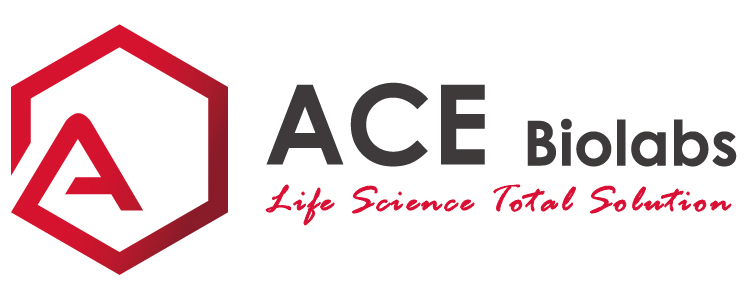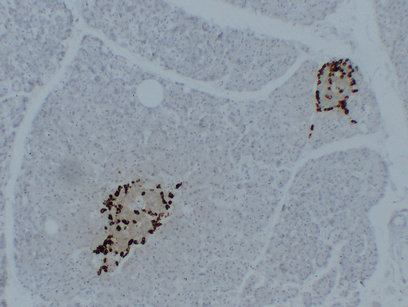Glucagon (PT1696) mouse mAb
- Catalog Number : A130249
- Number :
-
Size:
Qty : - Price : Inquiry
Introduction
Specificity:This antibody detects endogenous levels of human Glucagon. Heat-induced epitope retrieval (HIER) Citrate buffer of pH6.0 was highly recommended as antigen repair method in paraffin section.
Background:glucagon(GCG) Homo sapiens The protein encoded by this gene is actually a preproprotein that is cleaved into four distinct mature peptides. One of these, glucagon, is a pancreatic hormone that counteracts the glucose-lowering action of insulin by stimulating glycogenolysis and gluconeogenesis. Glucagon is a ligand for a specific G-protein linked receptor whose signalling pathway controls cell proliferation. Two of the other peptides are secreted from gut endocrine cells and promote nutrient absorption through distinct mechanisms. Finally, the fourth peptide is similar to glicentin, an active enteroglucagon. [provided by RefSeq, Jul 2008]
Function:
Function: Glicentin may modulate gastric acid secretion and the gastro-pyloro-duodenal activity. May play an important role in intestinal mucosal growth in the early period of life. GLP-1 is a potent stimulator of glucose-dependent insulin release. Play important roles on gastric motility and the suppression of plasma glucagon levels. May be involved in the suppression of satiety and stimulation of glucose disposal in peripheral tissues, independent of the actions of insulin. Have growth-promoting activities on intestinal epithelium. May also regulate the hypothalamic pituitary axis (HPA) via effects on LH, TSH, CRH, oxytocin, and vasopressin secretion. Increases islet mass through stimulation of islet neogenesis and pancreatic beta cell proliferaton. Inhibits beta cell apoptosis. GLP-2 stimulates intestinal growth and up-regulates villus height in the small intestine.
Subcellular Location:Cytoplasmic
Background:glucagon(GCG) Homo sapiens The protein encoded by this gene is actually a preproprotein that is cleaved into four distinct mature peptides. One of these, glucagon, is a pancreatic hormone that counteracts the glucose-lowering action of insulin by stimulating glycogenolysis and gluconeogenesis. Glucagon is a ligand for a specific G-protein linked receptor whose signalling pathway controls cell proliferation. Two of the other peptides are secreted from gut endocrine cells and promote nutrient absorption through distinct mechanisms. Finally, the fourth peptide is similar to glicentin, an active enteroglucagon. [provided by RefSeq, Jul 2008]
Function:
Function: Glicentin may modulate gastric acid secretion and the gastro-pyloro-duodenal activity. May play an important role in intestinal mucosal growth in the early period of life. GLP-1 is a potent stimulator of glucose-dependent insulin release. Play important roles on gastric motility and the suppression of plasma glucagon levels. May be involved in the suppression of satiety and stimulation of glucose disposal in peripheral tissues, independent of the actions of insulin. Have growth-promoting activities on intestinal epithelium. May also regulate the hypothalamic pituitary axis (HPA) via effects on LH, TSH, CRH, oxytocin, and vasopressin secretion. Increases islet mass through stimulation of islet neogenesis and pancreatic beta cell proliferaton. Inhibits beta cell apoptosis. GLP-2 stimulates intestinal growth and up-regulates villus height in the small intestine.
Subcellular Location:Cytoplasmic
General Information
| Reactivity | Human |
|---|---|
| Application | IHC |
| Host | Mouse |
| Clonality | Monoclonal |
| Conjugate | Non-conjugated |
| Uniprot | P01275 |
| Isotype | IgG2b, Kappa |
| Immunogen | Synthesized peptide derived from human Glucagon |
| Assay principle | IHC-p 1:100-500 |
| Sample type | paraffin section |
| Purity | The antibody was affinity-purified from mouse ascites by affinity-chromatography using specific immunogen. |
| Expression region | Liver,Pancreas |
| Storage buffer | Liquid in PBS containing 50% glycerol, 0.5% BSA and 0.02% sodium azide. |
| Storage instruction | -20°C/1 year |
| Research topic | regulation of peptide secretion, cell surface receptor linked signal transduction, G-protein coupled receptor protein signaling pathway, intracellular signaling cascade, behavior, feeding behavior, cell proliferation, response to endogenous stimulus, response to hormone stimulus, hormone-mediated signaling, response to organic substance,cellular response to hormone stimulus, regulation of hormone secretion, regulation of insulin secretion, regulation of secretion, regulation of cellular localization, |
| Alias | GCG |






.png)